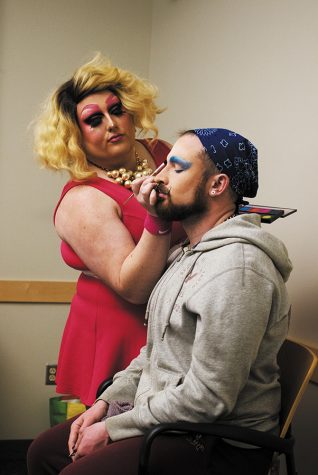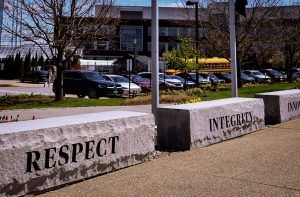Drag Queens inspire activism and individuality
April 10, 2019
Pink eyebrows and laughter filled the Davis Center at the latest installment of the Drag WERKshop series.
Fifteen participants sat behind vanity mirrors as they learned the essentials of drag makeup.

Drag queen Emoji Nightmare demonstrates the essentials of drag makeup on a willing volunteer April 4 at the Queer Student Union’s Feeling the Fantasy Makeup tutorial. The tutorial was the second event in a four-part Drag WERKshop series.
UVM’s Queer Student Union, in collaboration with Student Life, the Arts and Creativity learning community, and the Cultural Crossroads learning community hosted the Feeling the Fantasy Makeup tutorial April 4.
The tutorial was led by local drag queens Nikki Champagne and Emoji Nightmare.
The QSU is an activist, social programming and educational group, junior Carter Shapiro, the club’s president, said.
“This workshop series, and this one in particular, is a way that we can educate people and bring people together,” Shapiro said. “You can look at it as activism, because all the people that are participating, not all of them are gay, cis men.”
The tutorial was the second event in the four-part WERKshop series. The first event, “Strut Your Stuff,” involved a discussion on the complicated history of drag and a lesson on common drag choreography, Shapiro said.
“Drag has a pretty big history with transphobia and racism, and all that stuff,” Shapiro said. “It’s hard, because how do you consume something and take part in something that is super problematic in many aspects?”
The group discussed this question at the previous workshop.
Participants at the WERKshop had varying experience with makeup and drag. Burlington resident Amber Lampman first got into drag through “RuPaul’s Drag Race.”
“My skills aren’t as refined as I’d like them, so I figured coming to a class setting would be a good idea, because I can only learn so much from a YouTube tutorial,” Lampman said.
According to Champagne, they taught what is called the “standard pretty face,” or SPF. While the SPF was a femme look, Champagne and Nightmare emphasized that participants could alter their instructions to suit what they were looking for.
“There is no permission in drag,” Champagne said.
The workshop began as participants took a glue stick and ran it against their eyebrows, pinning them to their face before covering them with foundation so that they could be drawn over later.
The WERKshop was sophomore Alex Escaja-Heiss’ first experience with makeup.
“I’m not used to trying to adjust my appearance in such a drastic way,” Escaja-Heiss said. “It’s weird to look in the mirror and not see me.”
The event boosted queer visibility on campus, Shapiro said.
“I think it’s really revolutionary for someone to show up to something like this, with all of the stigma,” Shapiro said, “It’s mainly just revolutionary for the people who come and partake in this.”






